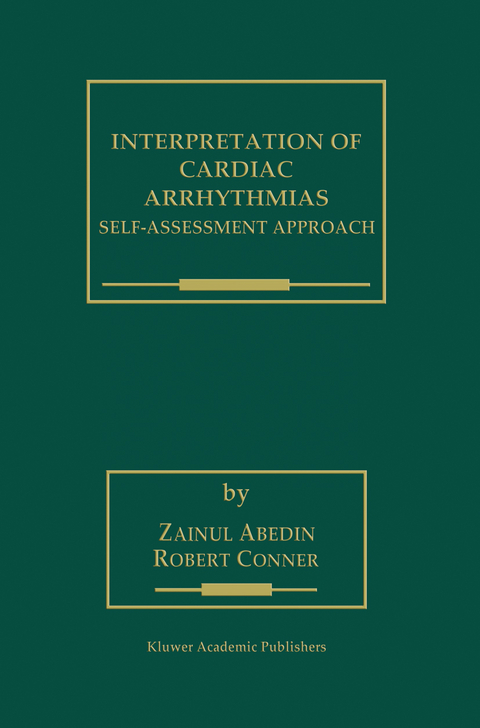
Interpretation of Cardiac Arrhythmias
Springer-Verlag New York Inc.
978-1-4613-7082-6 (ISBN)
Accurate diagnosis of arrhythmias is the goal of this volume. Before the clinician can accurately classify the multiple permutations of cardiac rhythm encountered in daily practice, several essential preconditions must be met. At the most basic level, the clinician must know the diagnostic criteria for each rhythm. Without a clear understanding of these criteria, an accurate differential diagnosis is impossible, and without accurate diagnosis, correct intervention is a mere matter of chance.
A second precondition of accurate rhythm diagnosis is an understanding of the mechanism of arrhythmias. Not uncommonly, two or more arrhythmic mechanisms coexist, confronting the clinician with a baffling mixture of apparently unrelated complexes and intervals. Without an understanding of the various arrhythmic mechanisms, simple and complex, the tangled skein of data can never be unraveled.
Finally accurate arrhythmia diagnosis depends on skill attained through practice. The competent electrocardiographer combines the skills of precise measurement and rational application of logic with broad theoretical knowledge. The pleasure of electrocardiography is seeing through the surface appearance to the inner workings.
Interpretation of Cardiac Arrhythmias presupposes no prior knowledge of arrhythmias, and progresses from basic to the complex. The didactic sections focus extensively on the mechanism of arrhythmia, using laddergrams and other diagramatic devices to help the student visualize what is happening with the cardiac conduction system. Extensive self-assessment sections enable students to apply critical skills and test their grasp of the diagnostic criteria.
1. The Electrocardiogram.- Anatomy of the conduction system.- The electrocardiogram.- ECG paper and rate calculation.- 2. The Sinus Rhythms.- Normal sinus rhythm.- Sinus arrhythmia.- Accelerated atrioventricular conduction.- Sinus tachycardia.- Sinus bradycardia.- Wandering atrial pacemaker.- Self-assessment section: Chapter 2.- 3. Axis Determination.- Lead systems.- Axis determination.- Self-assessment section: Chapter 3.- 4. The Atrial Arrhythmias.- Premature atrial complexes.- Ectopic atrial rhythm.- Atrial fibrillation.- Atrial flutter.- Atrial tachycardia.- Multifocal atrial tachycardia.- Posttachycardia sinus depression.- Differential diagnosis of supraventricular tachycardias.- References.- Self-assessment section: Chapter 4.- 5. Atrioventricular Block.- Prolonged PR interval (first-degree AV block).- Second-degree AV block.- Third-degree AV block.- References.- Self-assessment section: Chapter 5.- 6. Multilevel Atrioventricular Block.- Wenckebach conduction of supraventricular tachycardia.- Maintenance of even conduction ratios.- Wenckebach periods of alternate beats.- Wenckebach conduction at successive levels.- References.- 7. Sick Sinus Syndrome.- Sinoatrial exit block.- Sinus arrest.- Tachycardia—bradycardia syndrome.- Sinus node suppression.- References.- Self-assessment section: Chapter 7.- 8. Intraventricular Conduction Defects.- Fascicular block.- Bundle branch block.- Bifascicular block.- Bilateral bundle branch block.- Aberrant ventricular conduction.- Wenckebach periods in bundle branches.- Self-assessment section: Chapter 8.- 9. The Junctional Rhythms.- Junctional extrasystoles and rhythms.- Idiojunctional rhythm.- Double junctional rhythm.- Self-assessment section: Chapter 9.- 10. Escape and Capture.- Escape beats and rhythms.- Capture beats.-References.- Self-assessment section: Chapter 10.- 11. The Echo Phenomenon and Dual Pathways.- The echo phenomenon (reciprocation).- Different PR and RP intervals as a manifestation of dual pathways.- Dual ventricular response as a manifestation of dual pathways.- 12. The Wolff—Parkinson—White Syndrome.- Localization of accessory pathway using the surface ECG.- Self-assessment section: Chapter 12.- 13. Supraventricular Reentrant Tachycardia.- Atrioventricular nodal reentry tachycardia (AVNRT).- Bypass tract-mediated tachycardia (BTMT).- Diffential diagnosis: AVNRT versus BTMT.- Permanent junctional reciprocating tachycardia (PJRT).- Mahaim tachycardia.- Sinoatrial reentry tachycardia.- References.- Self-assessment section: Chapter 13.- 14. Concealed Conduction and Concealed Extrasystoles.- Concealed atrioventricuar reentry complicating wenckebach cycles.- Transseptal concealed conduction perpetuating aberrant ventricular conduction.- Concealed conduction suppressing impulse formation.- Concealed junctional extrasystoles.- References.- 15. The Ventricular Arrhythmias.- Ventricular extrasystoles.- Monomorphic ventricular tachycardia.- Differential diagnosis of wide-QRS tachycardias.- Polymorphic ventricular tachycardia.- Miscellaneous syndromes.- Bidirectional ventricular tachycardia.- Accelerated idioventricular rhythm.- Ventricular fibrillation.- References.- Self-assessment section: Chapter 15.- 16. Exit Block.- 17. Parasystole.- Self-assessment section: Chapter 17.- 18. Electronic Pacemakers.- Basic functional parameters.- NBG Pacemaker Code.- Pacemaker intervals.- Pacemaker malfunction.- Diagnosis of pacemaker malfunction.- Basic pacemaker timing cycles.- Dual chamber pacemaking timing cycles.- Self-assessment section: Chapter 18.
| Reihe/Serie | Developments in Cardiovascular Medicine ; 220 |
|---|---|
| Zusatzinfo | XI, 578 p. |
| Verlagsort | New York, NY |
| Sprache | englisch |
| Maße | 155 x 235 mm |
| Themenwelt | Medizinische Fachgebiete ► Innere Medizin ► Kardiologie / Angiologie |
| Studium ► 2. Studienabschnitt (Klinik) ► Anamnese / Körperliche Untersuchung | |
| ISBN-10 | 1-4613-7082-5 / 1461370825 |
| ISBN-13 | 978-1-4613-7082-6 / 9781461370826 |
| Zustand | Neuware |
| Haben Sie eine Frage zum Produkt? |
aus dem Bereich


